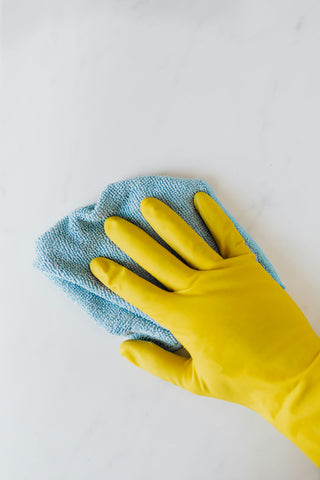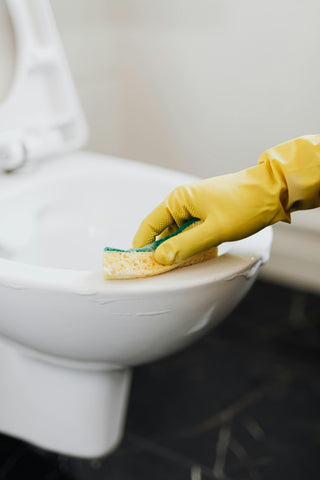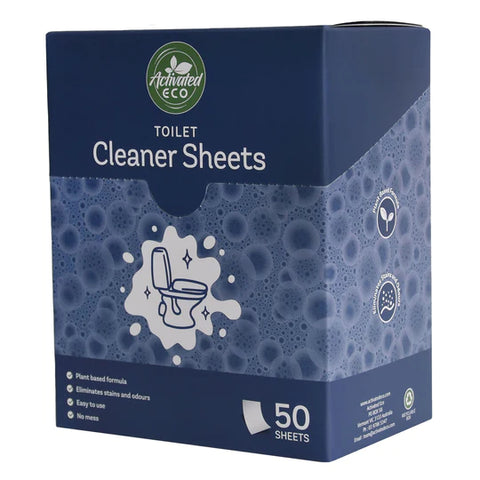How to Clean a Toilet
Learning how to clean a toilet properly is a task that might not be glamorous but is undeniably essential for maintaining a hygienic and fresh-smelling bathroom. We're here to guide you through the process.
This article dives into the nitty-gritty of toilet cleaning, covering everything from the basic supplies you'll need, to detailed steps for cleaning the bowl, seat, and outside of the toilet.
We'll also share expert tips on getting rid of hard water stains and removing persistent toilet rings.
Let's dive in and get that toilet shining!
What this article covers:- Supplies
- Clean the Bowl
- Clean the Seat
- Clean the Outside
- Getting Rid of Hard Water Stains
- How to Remove a Toilet Ring
Supplies
- Gloves
- Toilet brush
- Toilet cleaner sheets or tablets
- Disinfectant spray
- Paper towels or reusable cloth
- Scrubbing sponge
- Pumice stone (for hard water stains)
Clean the Bowl
Cleaning the toilet bowl is crucial for maintaining a hygienic bathroom. At Activated Eco, we offer the best toilet cleaner that gets the job done without damaging the ecosystem: our formidable stain-cleaning toilet cleaner sheets and small-batch Rosalina toilet tablets are the choices our customers love!
Step 1: Using Toilet Cleaner Sheets
Begin by donning gloves to protect your hands. Take one pre-measured sheet from your pack of cleaner sheets. No more is than that is necessary, thanks to their potent formulation!
Made from carefully selected plant-based ingredients, these sheets boast strong cleaning abilities while being good for the planet.
Their rapid dissolution technology means they quickly dissolve in water, releasing cleaning agents that lift tough stains and vanquish odours, all without the waste of bulky plastic containers. The sheets are septic tank safe, making them the best septic safe toilet cleaner we offer!
Never run out of sheets again with our subscription plan. We'll make sure you're always equipped, whether you opt for 50, 100, 200, or 300 sheets.
Step 2: Applying The Sheet
Place the sheet directly into the toilet bowl. Then wait a moment for it to dissolve. This process is mess-free, as they do not contain liquids which are liable to spill.
Step 3: Scrubbing
Use a toilet brush to scrub the bowl thoroughly. Ensure you reach under the rim and down into the u-bend, areas where dirt and bacteria tend to accumulate. This helps to dislodge and remove visible stains and hidden germs.
Our research indicates that regularly cleaning these often-neglected areas can reduce the buildup of harmful bacteria and maintain the overall cleanliness and hygiene of your bathroom.
Step 4: Flush For Freshness
Once you've scrubbed the entire bowl, flush the toilet, rinsing away the loosened dirt and grime, revealing a clean, fresh-smelling bathroom.
Clean the Seat
When it comes to maintaining a hygienic toilet, cleaning the seat is as important as scrubbing the bowl. The seat is one of the most touched parts of a toilet, making it a hotspot for germs and bacteria. \
Step 1: Preparation
Start by wearing gloves to protect your hands. Gather your cleaning supplies, including a disinfectant spray or solution and paper towels or reusable cloths. If using a spray, choose one that's designed to kill germs and bacteria.
Step 2: Apply Disinfectant
Spray the disinfectant evenly over the top and bottom of the toilet seat. Allow it to sit for a few minutes to kill germs and bacteria.
Step 3: Wipe Clean
After, use paper towels or a clean cloth to wipe the seat thoroughly. It's important to be thorough, covering every part of the seat, especially the areas that are often overlooked, like the hinges and the underside.

Based on our observations, these spots can harbour significant amounts of bacteria because of less frequent cleaning.
Step 4: Dry And Inspect
Finally, use a dry cloth to remove any remaining moisture. This prevents the growth of bacteria that thrive in moist environments.
Inspect the seat to ensure it's completely clean and free of any residue or streaks. If necessary, repeat the cleaning process for areas that need extra attention.
Clean the Outside
Cleaning the outside of the toilet is essential for a comprehensive clean, addressing areas that can accumulate dust, splashes, and germs. This includes the toilet base, back, and the tank.
Step 1: Dusting
Begin by dusting the entire exterior of the toilet to remove any loose dirt and dust. Use a dry cloth or a duster for this purpose.
Dusting the exterior of the toilet is easy to overlook, but removing loose dirt and dust at the beginning makes the subsequent cleaning more effective. By tackling dry debris first, you avoid creating a hard-to-clean mess when wet solutions are applied.
Step 2: Apply Cleaner
Spray a cleaner on the exterior surfaces of the toilet and let it sit for a few minutes to break down dirt and kill germs. Make sure you clean the handle too, as this is another high-contact area. Get into the nooks and crannies, like the surface between the lid and tank.
Step 3: Scouring
Use a sponge or cloth to clean the sprayed areas. Gently rub in circular motions to lift and remove dirt, grime, and any microbial presence that could lead to health concerns or unpleasant smells.

Step 4: Rinse And Dry
After scrubbing, wipe the exterior with a damp cloth to remove any remaining cleaner and loosened dirt. Follow up with a dry cloth to remove moisture, preventing the growth of bacteria.
Getting Rid Of Hard Water Stains
To tackle hard water stains, you'll need a product that can break down mineral deposits.. Start by applying the cleaning agent directly to the stained areas. Vinegar, being acidic, is particularly effective against hard water stains.
Allow it to sit for several hours or even overnight to break down the minerals. For tougher stains, a pumice stone can be used to scrub the affected areas. Scour gently in a circular motion until the stains are removed.
Our findings show that hard water stains are caused by minerals in the water that accumulate over time, leaving unsightly marks that can be tough to remove with regular cleaning.
These stains are not just cosmetic issues; they can also harbour bacteria, making it important to address them effectively. Consistency is the first step in how to keep toilet bowl clean.
How to Remove a Toilet Ring
Toilet rings are stubborn stains that form at the waterline and below, often caused by hard water, mineral deposits, and bacterial growth. For an eco-friendly approach, consider using Activated Eco's Rosalina toilet cleaning tablets, which clean and freshen your toilet without harsh chemicals.
Our blend harnesses the natural power of organic sodium hydrogen carbonate, food-grade citric acid, and 100% Australian Organic Castile Soap, combined with ACO Certified Rosalina oil.
After throwing two tablets in the bowl, let it sit for at least 15 minutes to allow the ingredients to work on the deposits before rinsing with a flush.
How often to clean toilet, you ask? We suggest once a week. Biweekly if your household has hard water issues.
Conclusion
Perfecting the skill of toilet cleaning is a cornerstone of maintaining a sanitary bathroom. From selecting the right supplies to tackling the bowl, seat, and exterior, each step is pivotal in ensuring your toilet not only looks clean but is also free from harmful bacteria and unsightly stains.
We've explored the effectiveness of Activated Eco's plant-based toilet cleaner sheets and Rosalina toilet cleaning tablets in achieving a sparkling clean bowl, detailed the importance of thoroughly cleaning and disinfecting the seat, and highlighted the necessity of addressing the often-overlooked exterior surfaces.
Elevate your toilet cleaning game with Activated Eco's innovative solutions. Browse our online store today and discover how our products can update your cleaning routine.
If you want to learn more, why not check out these articles below:
- How to Remove Limescale From Toilet
- Clean Toilet Cistern
- How to Clean Bottom of Toilet
- Cleaning Caravan Toilet
- How to Remove Scale Build Up in Toilet
- How to Remove Black Stains From Toilet Bowl
- How to Remove Yellow Stains From Toilet
- Best Toilet Cleaner for Tough Stains
- How to Remove Rust Stains From Toilet
- How to Clean Toilet Bowl Stains Without Scrubbing
- How to Remove Toilet Bowl Ring Stains
- How to Remove Stains From Toilet Bowl Rim
- Best Clothes Pegs
- How to Get Peg Marks Out of Clothes
- Pegs That Don't Mark Clothes

